New bottling line shrink wraps bottled water; includes monobloc rinser/filler/capper
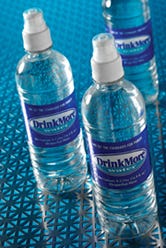
DrinkMore Custom Water (DCW), Gaithersburg, MD, produces and sells polyethylene terephthalate bottles of water ranging in size from 12 oz to 1.5 L under its DrinkMore brand, but the majority of its business is the design, production and delivery of custom-labeled bottles of water to a wide range of clients nationwide. It produces orders both large and small, with the majority of the customers being commercial businesses, but it has produced custom-label water for weddings, birthdays, bar mitzvahs, retirement parties and many other events, as well as for retailers looking to gain new business via label promotion. "We may run fifty different labels in one day, so the key to this operation is that we designed our labeling operation so that we can run as little as one case [24 bottles] for a customer, we can switch between different labels quickly, and we can print the labels for those short runs in-house," says DCW president John Walsh.
Clients that have purchased custom-labeled bottles include the U.S. Senate, the Robert Trent Jones Golf Club in Prince William County, VA, for sale at the Presidents Cup golf tournament, Microsoft Corp. and Best Buy.
DCW's in-house design staff works closely with its clients to develop unique label designs. In addition to a standard, pressure-sensitive label, it also offers a patented coupon label, which has a coupon area that is easily and neatly removed from the bottle. Clients can also use its labels to conduct contests, through the use of scratch-off areas directly on the bottle. Its labels are printed on state-of-the-art printing presses, and the company can reproduce photographic images or match PMS colors with no problem. DCW also can print its labels such that there are two different labels in sequence on each roll, so that they appear A-B/A-B. Printing labels in a sequential manner allows for half of the bottles in a case to have one label and half with another.
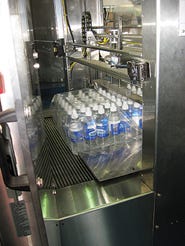
Wrapped bottles enter the shrink tunnel.
DCW's sister company, Drinkmore Water, opened its first water store in Rockville, MD, in 1993 to produce ultra-purified water for its customers to transport home for consumption. In 1996, DrinkMore Water began delivering its ultra-purified water to homes and offices in the Greater Washington and Baltimore region, and now it has more than 12,000 customers. In 2006, the company moved to a 40,000 sq-ft facility in Gaithersburg, where it moved its 3- and 5-gal water line (information about this line will follow in a later issue) and added the new PET bottling line owned by DCW. It also installed a new, state-of-the-art water purification facility in the plant.
Packaging the filled bottles was a major concern for DCW, so it installed a Series IL Model PH32HL intermittent-motion shrink wrapper with a custom-built infeed from Polypack, Inc. (www.polypack.com). "We wanted to eliminate paperboard from our packages, and this machine can run most of our bottles, even in twent-four-packs, without trays or pads," says Walsh. "I've worked with Polypack for a number of years, and they've always done an excellent job for me. Their service is great. One morning, my old shrink wrapper's main driveshaft broke, and Polypack machined a new shaft that day and shipped it to me overnight, and we were up and running the next day. In this business, you have to have confidence in your suppliers, so I never even thought about anyone but Polypack."
DCW runs three pack configurations—a 2x3, a 3x4 and a 4x6. During PD's visit, the machine was running a 4x6 24-pack of 0.5-L PET bottles, which were supplied by Plastipak Packaging, Inc. (www.plastipak.com). The bottles enter the PH32HL wrapper through four lane dividers, and when sensors above the lanes detect that the lanes are full, a gate releases six rows of bottles for packaging. A sensor triggers a motorized pusher assembly to push the bottles through the wrapping section of the machine, and the bottle-feeding process is repeated. A paperboard-pad dispenser from MGS Machine Corp. (www.mgsmachine.com) is mounted in front of the film curtain and will place a pad on a popup plate before each group of bottles enters the plate, if the plant is running a pack that requires the paperboard pad.
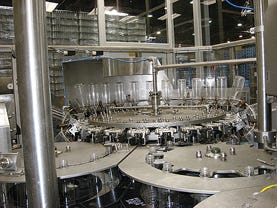
PET bottles are washed in the first module of the monobloc rinser/filler/capper. Next, ultra-pure water is filled by a gravity filler, after which the bottles are capped.
Two rolls of film are mounted on the end of the machine and enter the machine perpendicular to the direction of infeed-bottle travel. The 3-mil, high-clarity PE film is supplied by Film Source Intl. (www.filmsourceinternational.com), a Polypack affiliate. Each layer of film passes over a series of dancer bars that feed it into the wrapper. The bottles are pushed through the film curtain and travel on top of the bottom layer through the wrapping section, while the top layer travels concurrently above the bottles. The leading edges of the two pieces are heat-sealed together as the group leaves the wrapper. This simultaneously seals the back edges of the two layers of film on the leading group of bottles and the leading edges of the film on the following group. The seal bar also cuts the film apart between groups of bottles. Multiple sensors throughout the wrapper monitor the operation and shut down the machine and trigger an alarm if any problems occur. For example, if the bottle pusher takes too long to travel through the wrapping section, it will initiate the shutdown and alarm. The bottles then enter the shrink tunnel, which tightly shrinks the film around the bottles and creates a very tight bundle.
The wrapper incorporates a programmable-logic controller from Telemecanique (www.telemecanique.com), as well as a color-touchscreen operator interface with message display and self diagnostics. The unit includes preprogrammed settings for conveyor speeds, timing and temperature settings for fast, accurate setup when changing products.
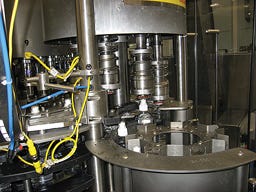
A magnetic clutch system in the eight-head capper tightens the caps to the set torque level as the bottles travel around the machine.
To start the packaging operation, the PET bottles, which are delivered on pallets, are dumped into the floor hopper of an M-500 unscrambler from Pace Packaging Corp. (www.pacepkg.com). An elevator lifts the bottles into a rotating disc that discharges them into the standup unit in a horizontal position. If the bottles are oriented with the bottom end leading, they discharge in an upright position onto the next conveyor. If the bottles are oriented with the top, open end leading, a hook flips them over so the closed end is leading, and they are then stood up on the takeaway conveyor.
The bottles are delivered to a monobloc RFC24-24-8 rinser/filler/capper from Linker Equipment Corp. (www.linkercorp.com) that is installed inside a Class 100,000 clean room manufactured by Clean Air Products (www.cleanairproducts.com). The room includes five overhead, high-efficiency particulate air-filter units, which maintain a positive pressure in the room, and there is also controlled entry to optimize sanitation. The 24-24-8 designation means the rinser has 24 heads, the filler has 24 heads, and the capper has eight heads. The system incorporates Linker's neck-handling system, which includes a 20-ft infeed section of air conveyor and modifications to the rinser/filler/capper to handle PET bottles by the neck. This eliminates most change requirements for different bottle sizes, because the system only requires bottle-diameter changeparts for large variations in diameter. DCW takes advantage of this feature by being able to run 12-, 16.9- 20- and 24-oz bottles with the same set of changeparts in the machine.
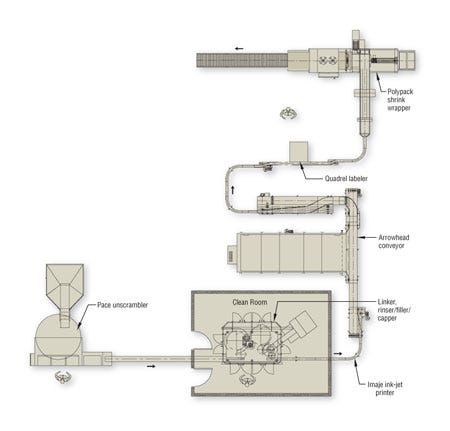
Water bottling line.
Bottles enter the rotating rinser through a starwheel and, after they are inverted, water is sprayed up into them. The water drains, and the bottles are returned to an upright position as they enter the starwheel that transfers them to the gravity filler. An electronic control maintains the level in the filler bowl to ensure a proper fill level in the bottles. The filled bottles then travel through a starwheel to the cap-in-head capper. Caps, which are supplied by Alcoa Closure Systems Intl. (www.alcoacsi.com), travel down a chute from an overhead hopper and are released from the chute as the bottles enter the capper. A magnetic clutch system tightens the caps to the set torque level as the bottles travel around the capper.
Sensors on the infeed air conveyor change the speed of the system to accommodate the bottles entering the unit. If a bottle is missing on the conveyor, a shift register tracks the empty position through the system, stops product from dispensing and prevents the release of a cap at the relevant position. A sensor in the cap chute rejects an upside down cap in the chute. The system is equipped with a PLC and an operator panel from Rockwell Automation (www.rockwellautomation.com).
Bottles leaving the cleanroom have their lot code and production date imprinted on their shoulders by an ink-jet printer from (BOD)Imaje (www.imaje.com) and travel past an accumulation table from Arrowhead Conveyor Corp. (www.arrowheadsystems.com), which also supplied the tabletop conveyors throughout the line. The bottles pass through a single-filing section and travel to the labeling area.
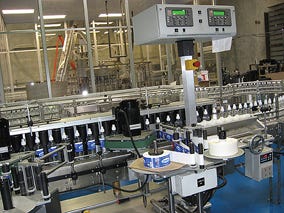
This custom-built labeler incorporates two labeling heads that can operate alternately to facilitate running short runs of bottles with different labels with minimum downtime.
As mentioned previously, the key to this operation is the ability to run bottles with as many as 50 different labels during a day's production. To accomplish this, DCW installed a custom-built labeler with two side-by-side labeling heads from Quadrel Labeling Systems (www.quadrel.com). The labeler has been constructed so that the label heads can be swung out away from the product stream to rethread one labeling head, while the other head is labeling, and then can be easily swung back into the labeling position. Thus, while one labeler is applying labels, the other labeler is being set up with the next batch of labels. The line is only stopped for a few seconds to switch from one labeler to the other. In this operation, a roll of labels is mounted horizontally on each labeler, and labels are pulled through the unit by a drive mounted just beyond the peel plate. A sensor detects a bottle entering the labeler and starts a stepper motor on the label drive. Another sensor detects the gap between labels and stops the motor after the label is dispensed. A continuous belt holds the label against the bottle and rotates the bottle as the label is applied. In this operation, one motor drives the infeed screw, the conveyor and the vertical rollers so that the entire system is synchronized. The stepper motors on the label drives are separate.
Immediately before the bottles enter the labeler, there is a photoeye counter and pneumatic gate. The operator enters the exact number of bottles required for an order into the counter, and the gate actuates and admits the set number of bottles. It stops the bottle flow once the desired count is reached. Once the gate closes, the operator switches labeling heads, resets the counter and resumes labeling operations with the new label in less than a minute. The labels are supplied by Discount Labels (www.discountlabels.com).
Bottles leaving the labeler are conveyed to the shrink wrapper as described previously, and the finished packs are manually palletized.
More information is available:
Polypack, Inc., 727/578-5000. www.polypack.com.
Alcoa Closure Systems Intl., 317/390-5000. www.alcoacsi.com.
Arrowhead Conveyor Corp., 920/235-5562. www.arrowheadsystems.com.
Clean Air Products, 763/425-9122.www.cleanairproducts.com.
Discount Labels, 800/995-9500. www.discountlabels.com.
Film Source Intl., 727/578-3003. www.filmsourceinternational.com.
Imaje, 800/462-5334. www.imaje.com.
Linker Equipment Corp., 908/353-0700. www.linkercorp.com.
MGS Machine Corp., 763/425-8808. www.mgsmachine.com.
Pace Packaging Corp., 973/227-1040. www.pacepkg.com.
Plastipak Packaging, Inc., 734/455-3600. www.plastipak.com.
Quadrel Labeling Systems, 440/602-4700. www.quadrel.com.
Rockwell Automation, 414/382-2000. www.rockwellautomation.com.
Telemecanique, 888/778-2733. www.telemecanique.com.
About the Author(s)
You May Also Like


